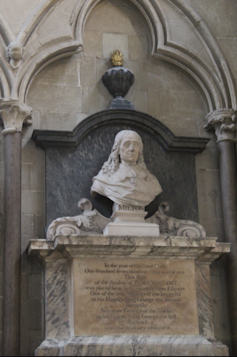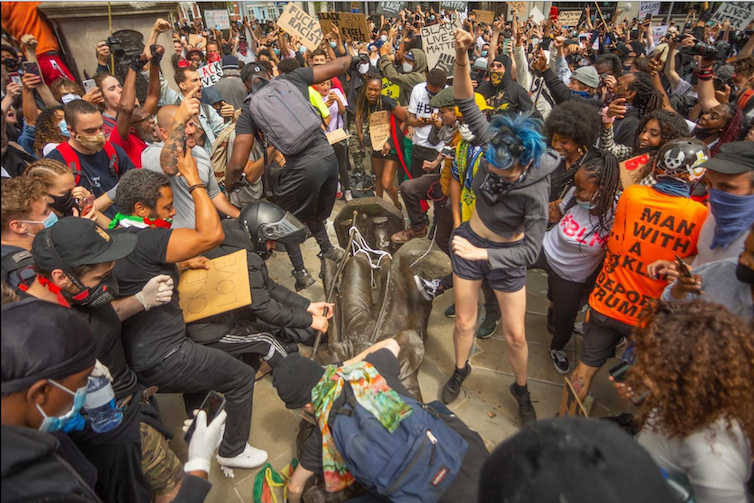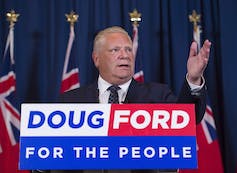The long-awaited government guidance on the official “retain and explain” policy suggests the UK’s contested statues and monuments be retained as long as additional context is provided. But given their controversial past, how do we go about that?
Done properly and creatively, with adequate funding and accurate, innovative storytelling, this could throw light on the different ways in which we might understand Britain’s past.
The guidance has been several years in the making. The 2020 toppling of the Bristol statue of 17th-century slave trader Edward Colston led to contentious debate. A trial for criminal damage ensued but the “Colston Four” were cleared, their defence arguing that the act was “on the right side of history”.
Dented and defaced, the statue was later put on display in Bristol, where thousands flocked to see it. The monument was alive and relevant as never before – a good example of how seeing statues afresh can help to unlock a fuller understanding of our past, and the forces that shaped it.
Greenhill 22 / Wikipedia, CC BY
Historian David Olusoga has responded to the retain and explain policy by pointing out its crucial flaws, arguing that statues were “validation and memorialisation” rather than history, and that they represented the interests and values of elite white men rather than wider society.
Olusoga’s point is valid. In the majority of cases, statues and monuments were raised by those who could afford to pay for them and who wished to promote their own interests. We see this when we look at any type of monument, even in iconic national spaces like Poets’ Corner in Westminster Abbey.
The case of William Benson
A good example is the monument to the poet John Milton, celebrated author of Paradise Lost. It’s hard to dispute that Milton merits a memorial, given the enormous cultural influence and poetic achievement of his work.
But the poet’s expensive monument is not really about him at all. As the abbey’s website openly concedes, the inscription on the plinth says far “more about the donor than the poet”:
… This bust of the author of Paradise Lost was placed here by William Benson Esquire, one of the two Auditors of the Imprests to his Majesty King George the second, formerly Surveyor General of the Works to his Majesty King George the first.
So, Milton’s prominent monument in Poets’ Corner, viewed by thousands every year, celebrates Benson as a sort of posthumous patron and protector of our nation’s literary culture.

GTR/Wikipedia, CC BY
In fact, more official accounts portray Benson very differently. During his brief tenure as surveyor to the king – a role celebrated on Milton’s monument – he oversaw what contemporaries called “the most disastrous episode in the whole history of the royal works”.
Benson managed to get himself sacked from this role and narrowly avoided prosecution when he lied to the House of Lords that their chamber was in imminent danger of collapse. He then proceeded to undertake structural investigations which caused damage to what had been a perfectly safe space. As contemporaries noted, his claims were found to be “false and groundless and occasioned a long interruption and delay of the public business in Parliament and much expense to His Majesty.”
Further inglorious behaviour followed. Less than a decade after his sacking, Benson stood to be MP for Shaftesbury, a seat he had held twice before. He received just four votes. Enraged, he turned off the water supply to the town.
This, then, is the man who managed to have himself commemorated in the most revered of our national spaces. What, we should ask, made that act possible? The answer, as one contemporary historian of the Abbey pointed out, was Benson’s own wealth and vanity.
What does ‘explaining’ mean?
The problem with monuments and statues goes far beyond the issue of the legacies of slavery, important as that issue is. We need to learn to question all monuments rather than read them as factual documents of the past.
Monuments cost huge amounts of money, and it takes influence to get them erected. We must always keep this in mind when we look at them, and question the message they seek to promote. As cultural artefacts, monuments can be a useful tool to help us understand history. But Olusoga is right to state that they are not history itself. As the case of Benson shows, we simply cannot take them at face value.

Andy Sillett/Alamy
There are, though, exciting ways that monuments could be used to throw light on the events of the past. They hold the possibility of being key objects for understanding the writing of history itself, and of how biased and complex that act can be.
The pressing question now is how we might begin to undertake that work. To date, the most useful attempts to explain have been through acts deemed as criminal vandalism, such as the toppling of Bristol’s Colston statue.
What, then, does the “explain” part of the government’s policy actually entail? Who will be tasked with deciding how that explaining works in non-criminal ways? And what financial investment will go into it?
The answers, as the official guidance suggests, seem to lie with the custodians of these works:
If custodians decide that an explanation is needed, it does not have to be a plaque or textual, and a range of approaches can be considered … There are many ways to explain, and the policy encourages innovation in alternative media, including creative ways to explain and contextualise the story of the person or event that is commemorated.
Examples of best practice are provided. But as laudable as these interventions may be, many of them – such as temporary exhibitions or small plaques – may easily escape notice and have little impact or legacy. Ultimately, the policy advocates the retention of all contested monuments, even allowing the custodian to decide that no action in explaining is needed.
It is hard to judge, then, how effective this new government policy will prove. Retaining a statue or monument takes very little work; explaining it is a mammoth and contested task. We can only hope that the custodians of our heritage have the necessary resources and support to take it on.

Looking for something good? Cut through the noise with a carefully curated selection of the latest releases, live events and exhibitions, straight to your inbox every fortnight, on Fridays. Sign up here.




